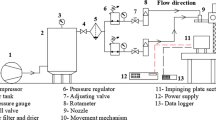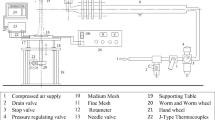Abstract
Herein, an experimental attempt is conducted to research thermal and flow behaviors of an impinging jet exiting from a coaxial type nozzle with a conical outer and a circular inner outlets. The experiments include four different values of the cone angle (Φ = 0°, 10°, 20° and 30°) and several values of the separation distance between the nozzle outlet and the target surface (0.5 ≤ H / D ≤ 6). Tests are performed for a single value of total flowrate (1.33 × 10−3 m3 s−1). It is revealed that the local Nusselt numbers on the target surface increase with decreasing separation distance. Especially, in the close-range impingement conditions (H / D ≤ 2), the cone angle of 20o performs the optimum thermal performance. Both the rate and spatial uniformity of convective heat transfer strongly depend on the coupling of the nozzle-to-plate distance and angle. From the flow dynamics aspect, wall pressure distributions are measured, and positive and negative (subatmospheric) peaks are observed depending on the combined influence of angle and distance.








Similar content being viewed by others
Abbreviations
- A r :
-
circular area on the plate [m2]
- D :
-
outer diameter of the outer flow passage [m]
- D i :
-
diameter of the inner circular passage [m]
- H :
-
distance between the target surface and the nozzle outlet [m]
- Nu :
-
local Nusselt number, Nu = h D/k
- Q :
-
volumetric flowrate [m3 s−1]
- P :
-
pressure [Pa]
- r∗:
-
dimensionless radial distance, r ∗ = r/D
- R :
-
Correlation coefficient
- r :
-
radial distance [m]
- Re:
-
Reynolds number, Re = um Di/v
- u m :
-
mean velocity [m s−1]
- Φ∗:
-
Modified cone angle, Φ ∗ = Φ (180/π)
- a :
-
(atmospheric)
- j :
-
(jet)
- o :
-
(outer)
- st :
-
(stagnation)
- tot :
-
(total)
References
Fenot M, Dorignac E (2016) Heat transfer and flow structure of an impinging jet with upstream flow. Int J Therm Sci 109:386–400. https://doi.org/10.1016/j.ijthermalsci.2016.06.010
Singh D, Premachandran B, Kohli S (2017) Double circular air jet impingement cooling of a heated circular cylinder. Int J Heat Mass Transf 109:619–646. https://doi.org/10.1016/j.ijheatmasstransfer.2017.02.035
Dua X, Yang Z, Jin Z, Xia C, Bao D (2018) A comparative study of passive control on flow structure evolution and convective heat transfer enhancement for impinging jet. Int J Heat Mass Transf 126:256–280. https://doi.org/10.1016/j.ijheatmasstransfer.2018.01.061
Trinh XT, Fenot M, Dorignac E (2017) Flow and heat transfer of hot impinging jets issuing from lobed nozzles. Int J Heat Fluid Flow 67:185–201. https://doi.org/10.1016/j.ijheatfluidflow.2017.08.010
Colucci DW, Viskanta R (1996) Effect of nozzle geometry on local convective heat transfer to a confined impinging air jet. Exp Therm Fluid Sci 13:71–80. https://doi.org/10.1016/0894-1777(96)00015-5
Lee J, Lee SJ (2000) The effect of nozzle configuration on stagnation region heat transfer enhancement of axisymmetric jet impingement. Int J heat mass Transf 43:3497–3509. https://doi.org/10.1016/S0017-9310(99)00349-X
Lee DH, Song J, Jo MC (2004) The effects of nozzle diameter on ımpinging jet heat transfer and fluid flow. J heat transfer 126:554–557. https://doi.org/10.1115/1.1777583
Meena HC, Reodikar SA, Vinze R, Prabhu SV (2016) Influence of the shape of the orifice on the local heat transfer distribution between smooth flat surface and impinging incompressible air jet. Exp Thermal Fluid Sci 70:292–306. https://doi.org/10.1016/j.expthermflusci.2015.09.018
Ahmed ZU, Al-Abdeli YM, Guzzomi FG (2016) Heat transfer characteristics of swirling and non-swirling impinging turbulent jets. Int J Heat Mass Transf 102:991–1003. https://doi.org/10.1016/j.ijheatmasstransfer.2016.06.037
Ahmed ZU, Al-Abdeli YM, Guzzomi FG (2017) Flow field and thermal behaviour in swirling and non-swirling turbulent impinging jets. Int J Therm Sci 114:241–256. https://doi.org/10.1016/j.ijthermalsci.2016.12.013
Crispo CM, Greco CS, Cardone G (2018) Convective heat transfer in circular and chevron impinging synthetic jets. Int J Heat Mass Transf 126:969–979. https://doi.org/10.1016/j.ijheatmasstransfer.2018.06.062
Terekhov VI, Kalinina SV, Sharov KA (2016) An experimental investigation of flow structure and heat transfer in an impinging annular jet. Int Commun Heat Mass Transf 79:89–97. https://doi.org/10.1016/j.icheatmasstransfer.2016.10.011
Markal B, Aydin O, Avci M (2012) Exergy analysis of a counter-flow Ranque-Hilsch vortex tube having different helical vortex generators. Int J Exergy 10(2):228–238. https://doi.org/10.1504/IJEX.2012.045867
Habib MA, Whitelaw JH (1980) Velocity characteristics of confined coaxial jets with and without swirl. J Fluids Eng 102:47–53. https://doi.org/10.1115/1.3240623
Mahmud T, Truelove JS, Wall TF (1987) Flow characteristics of swirling coaxial jets from divergent nozzles. J Fluids Eng 109:275–282. https://doi.org/10.1115/1.3242661
Singh P, Chander S (2018) Heat transfer and fluid flow characteristics of a pair of interacting dual swirling flame jets impinging on a flat surface. Int J Heat Mass Transf 124:90–108. https://doi.org/10.1016/j.ijheatmasstransfer.2018.03.034
Celik N, Eren H (2009) Heat transfer due to impinging co-axial jets and the jets’ fluid flow characteristics. Exp Thermal Fluid Sci 33:715–727. https://doi.org/10.1016/j.expthermflusci.2009.01.007
Celik N (2011) Effects of the surface roughness on heat transfer of perpendicularly impinging co-axial jet. Heat Mass Transf 47:1209–1217. https://doi.org/10.1007/s00231011-0785-9
Markal B (2018) Experimental investigation of heat transfer characteristics and wall pressure distribution of swirling coaxial confined impinging air jets. Int J Heat Mass Transf 124:517–532. https://doi.org/10.1016/j.ijheatmasstransfer.2018.03.101
Markal B (2019) The effect of Total flowrate on the cooling performance of swirling coaxial impinging jets. Heat Mass Transf 55:3275–3288. https://doi.org/10.1007/s00231-019-02653-7
Markal B, Aydin O (2018) Experimental investigation of coaxial impinging air jets. Appl Therm Eng 141:1120–1130. https://doi.org/10.1016/j.applthermaleng.2018.06.066
Dinesh KKJR, Kirkpatrick MP, Jenkins KW (2010) Investigation of the influence of swirl on a confined coannular swirl jet. Comput Fluids 39:756–767. https://doi.org/10.1016/j.compfluid.2009.12.004
Chouaieb S, Kriaa W, Mhiri H, Bournot P (2017) Swirl generator effect on a confined coaxial jet characteristics. Int J Hydrog Energy 42:29014–29025. https://doi.org/10.1016/j.ijhydene.2017.08.061
Ko NWM, Kwan ASH (1976) The initial region of subsonic coaxial jets. J Fluids Mech 73(2):305–332. https://doi.org/10.1017/S0022112076001389
Kline SJ, McClintock FA (1953) Describing uncertainties in single-sample experiments. Mech Eng 75(1):3–8
Ianiro A, Cardone G (2012) Heat transfer rate and uniformity in multichannel swirling impinging jets. Appl Therm Eng 49:89–98. https://doi.org/10.1016/j.applthermaleng.2011.10.018
Öztekin E, Aydin O, Avcı M (2013) Heat transfer in a turbulent slot jet flow impinging on concave surfaces. Int Commun Heat Mass Transf 44:77–82. https://doi.org/10.1016/j.icheatmasstransfer.2013.03.006
Lytle D, Webb BW (1994) Air jet impingement heat transfer at low nozzle-plate spacings. Int J Heat Mass Transf 37:1687–1697. https://doi.org/10.1016/0017-9310(94)90059-0
Eiamsa-ard S, Wongcharee K, Eiamsa-ard P, Thianpong C (2010) Heat transfer enhancement in a tube using delta-winglet twisted tape inserts. Appl Therm Eng 30:310–318. https://doi.org/10.1016/j.applthermaleng.2009.09.006
Eiamsa-ard S, Nanan K, Wongcharee K (2015) Heat transfer visualization of co/counter-dual swirling impinging jets by thermochromic liquid crystal method. Int J Heat Mass Transf 86:600–621. https://doi.org/10.1016/j.ijheatmasstransfer.2015.03.031
Abdel-Fattah A (2007) Numerical and experimental study of turbulent impinging twin jet flow. Exp Thermal Fluid Sci 31:1061–1072. https://doi.org/10.1016/j.expthermflusci.2006.11.006
Ozmen Y (2011) Confined impinging twin air jets at high Reynolds numbers. Exp Thermal Fluid Sci 35:355–363. https://doi.org/10.1016/j.expthermflusci.2010.10.006
Walker JDA, Smith CR, Cerra AW, Doligalski TL (1987) The impact of a vortex ring on a wall. J Fluid Mech 181:99–140. https://doi.org/10.1017/S0022112087002027
Benhacine A, Kharouna N, Khezzar L, Nemouchi Z (2012) Large eddy simulation of a slot jet impinging on a convex surface. Heat Mass Transf 48:1–15. https://doi.org/10.1007/s00231-011-0835-3
Huang L, EL-Genk MS (1998) Heat transfer and flow visualization experiments of swirling, multi-channel, and conventional impinging jets. Int J Heat Mass Transf 41:583–600. https://doi.org/10.1016/S0017-9310(97)00123-3
Schafer DM, Ramadhyani S, Incropera FP (1992) Numerical simulation of laminar convection heat transfer from an in-line array of discrete sources to a confined rectangular jet. Num Heat Transf Part A: Appl: Int J Comput Methodol Transf 22:121–141. https://doi.org/10.1080/10407789208944762
Author information
Authors and Affiliations
Corresponding author
Ethics declarations
Conflict of interest
On behalf of all authors, the corresponding author states that there is no conflict of interest.
Additional information
Publisher’s note
Springer Nature remains neutral with regard to jurisdictional claims in published maps and institutional affiliations.
Rights and permissions
About this article
Cite this article
Markal, B., Avci, M. & Aydin, O. Conical coaxial impinging air jets: angle effect on the heat transfer performance. Heat Mass Transfer 56, 3135–3146 (2020). https://doi.org/10.1007/s00231-020-02925-7
Received:
Accepted:
Published:
Issue Date:
DOI: https://doi.org/10.1007/s00231-020-02925-7




